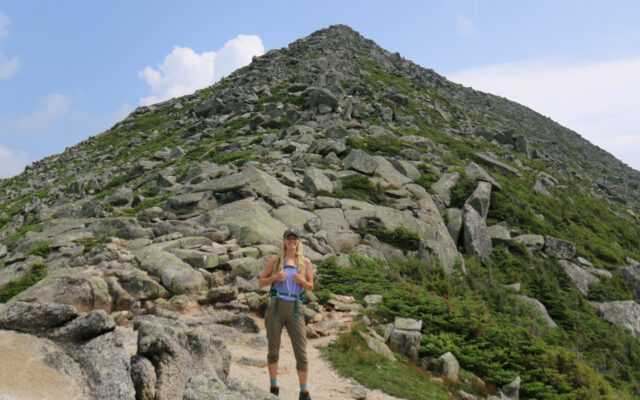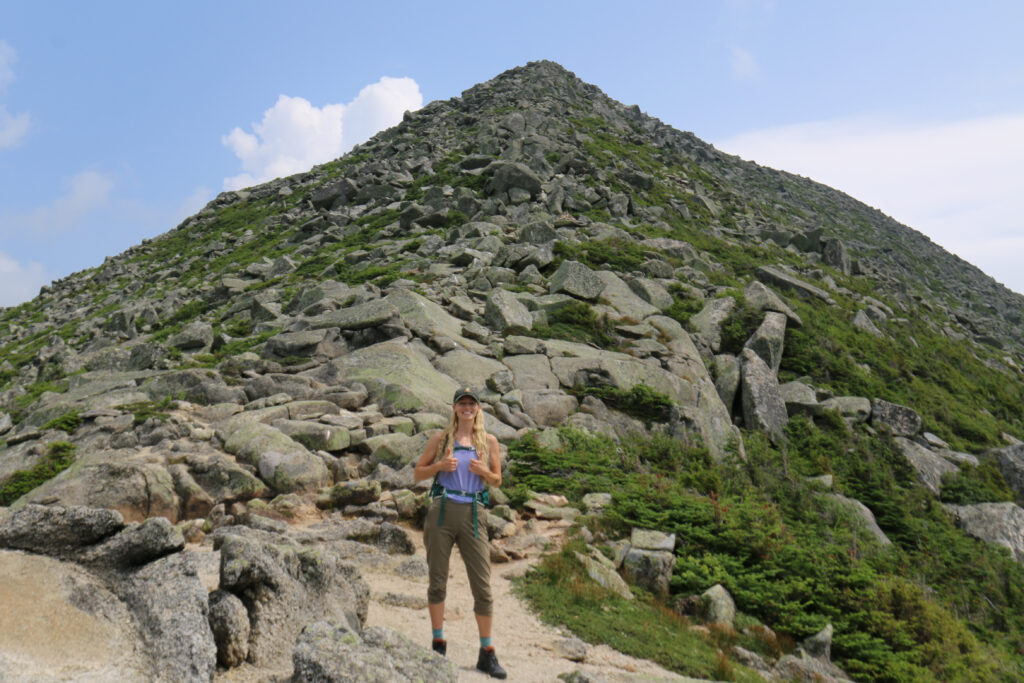
Why I am not afraid to hike alone in Maine
By Aislinn Sarnacki
Just before sunrise, I entered the dense forest of Baxter State Park. My headlamp illuminated the trees, but before long, I turned it off, allowing my eyes to adjust to the faint predawn light. Stepping over rain-soaked tree roots and slick rocks, I began my solo hike up Maine’s tallest mountain.
Rising 5,267 feet above sea level, Katahdin is arguably the most challenging day hike in Maine. I’ve climbed it many times and many ways. As a Registered Maine Guide, I’ve guided clients on the mountain.
Yet many people would disagree with my choice to hike it alone.
Solo wilderness travel is a matter of hot debate. In many ways, it can be riskier to hike alone rather than with a companion or group. The same can be said for other outdoor activities like canoeing, camping, skiing and snowshoeing. So why take the risk?

HUNT TRAIL — Bangor Daily News Outdoors contributor Aislinn Sarnacki poses for a self-portrait while hiking down Hunt Trail on Katahdin last month in Baxter State Park. The trail traverses a dramatic, rocky ridge.
Simply put, for me, the rewards of solo outdoor experiences often outweigh the risks. But in order for that to be the case, I have to reduce my risks as much as possible by planning and being prepared.
Earlier this summer, I spoke on the panel “A Guide to Solo Wilderness Travel†at the 17th annual Thoreau Wabanaki Trail Festival in Greenville. Joining me on the panel were two inspiring women, Wendy Weiger and Alexandra Conover Bennett. Their stories of independent adventuring and off-the-grid living made me feel not so alone about enjoying solo excursions.
Yet I’m not like them — not exactly.
Both have lived through a Maine winter in off-the-grid cabins, alone, for months. That’s incredible. But it doesn’t appeal to me, at least not right now. I prefer short solo adventures — a day, two days, maybe a week.
It got me thinking. I used to believe that solo adventuring was only for certain people. Now I believe the opposite.
Solo wilderness experiences are for everyone. Those experiences can vary greatly in length, difficulty and remoteness. For instance, even if you don’t consider yourself outdoorsy, I think you would benefit from sitting alone at your local park for an hour — just you and the soft grass and the oak tree sheltering you from the sun.
I believe that connecting with nature is a deep-seated need for all humans — and that’s far from an original thought. A horde of influential writers have harped about it. For example, celebrated American author Edward Abbey wrote, “Wilderness is not a luxury but a necessity of the human spirit, and as vital to our lives as water and good bread.”
The sound of a bird singing can soothe the nerves, just like the cold water of a clear stream washing over your feet. Something inside us knows that we belong out in the fresh air.
But why do it alone? Can’t you connect with nature while among other people? Yes, I think you can.
From my experience, though, it’s easier to feel that connection when no one else is around.
When alone in the wilderness, I feel at once vulnerable and empowered. I think that sensation should be felt by everyone at some point in their lives. But that doesn’t mean they have to hike Katahdin alone. Sitting by yourself on a riverbank will do. Or perhaps you prefer a meadow or a beach.
During the panel discussion, Bennett suggested that if you’ve never camped alone before (but want to), pitch a tent in your backyard. This helps you gain confidence and become comfortable with your gear while having the safety net of your home nearby.
I wish I’d done that when I was younger. Instead, I tried to jump into camping alone when I was in college. With a loaded backpack, I hiked out to a campsite on the ocean and pitched my tent. Then I felt this creeping discomfort and loneliness. I wasn’t afraid of anything in particular — not bears or wendigos or other campers. I just felt uncomfortable. So I packed my tent back up and hiked out.
It was years before I had the confidence to camp alone. But eventually, I did it. Now it’s not so scary.
Since I’m encouraging you to spend time outdoors by yourself, I’d be remiss not to mention the importance of taking safety measures. Most importantly, tell someone about your plans and agree to check in with them when you return from the wilderness — even if it’s just an easy day hike.
Planning and preparing for your adventure will make you feel safer and more confident, yet if you aren’t used to spending time alone in the wilderness, you might feel lonely or uncomfortable. In that case, just remember the words of famous conservationist Rachel Carson: “In nature, nothing exists alone.â€
Everything is connected: the flora and fauna, water and wind. Once you enter an outdoor space, you become a part of that intricate web.
During my recent hike of Katahdin, I exercised extra care, cognizant of every step, always taking the safest route.
As I clambered over boulders on a dramatic ridge, I felt a presence in the rough granite that scraped the palms of my hands, as if the mountain itself were my companion for the day. It’s that type of wonderful, deep connection that I think only comes from heading into the wilderness alone.